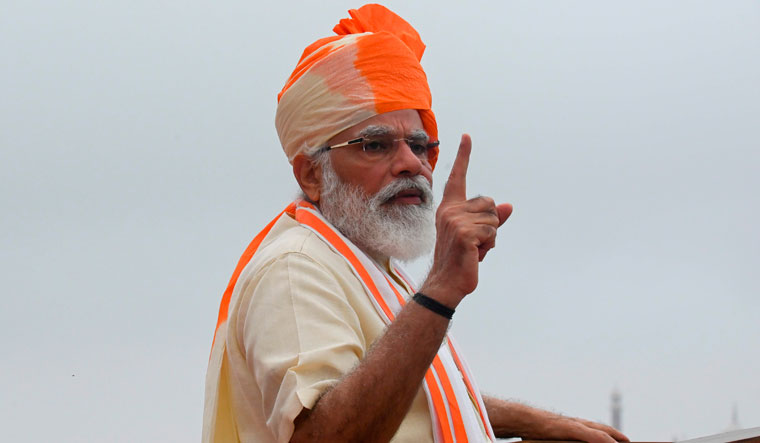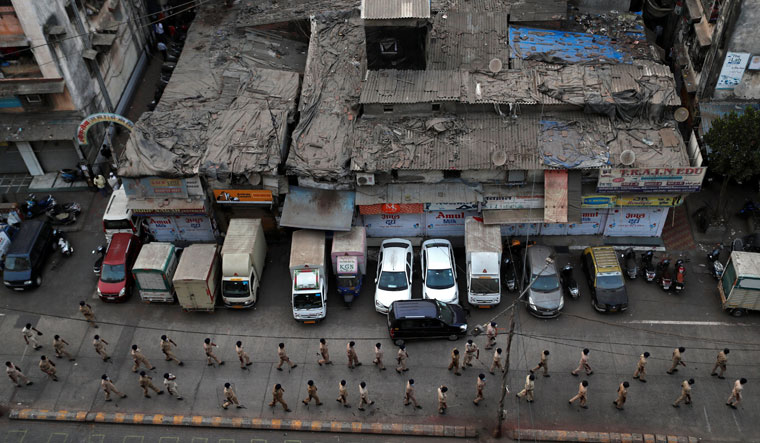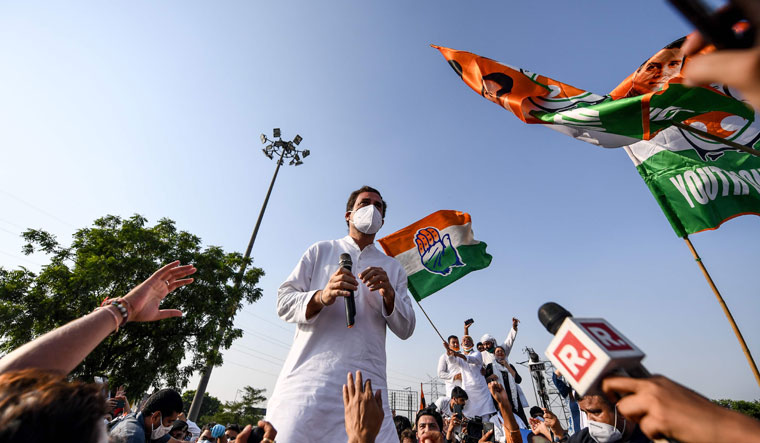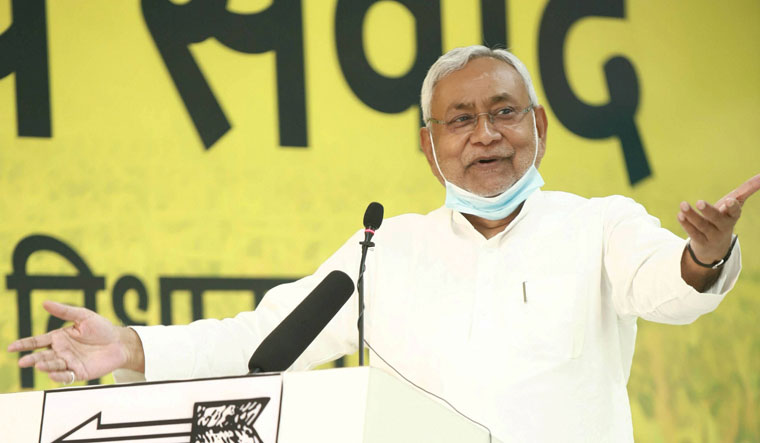It was a punishing year in more ways than one. Raging street protests against the Citizenship (Amendment) Act and the National Register of Indian Citizens flagged off a crisis-ridden year. Then the country shot up to the top of the Covid-19 charts, while the economy plunged. Border tensions with China soared. The spectre of lakhs of migrants trudging back to their hometowns and villages in the wake of a strict lockdown became the defining picture of the country's fight against the pandemic. Unemployment figures reached an all-time high.
If the year began with protests, the final month provided Prime Minister Narendra Modi his biggest challenge of 2020 as thousands of farmers laid siege on the national capital, seeking a repeal of three contentious farm laws passed by the Centre.
Despite the crises, his popularity remains untarnished, save for the effects of the farmers' unrest, the full political impact of which is yet to be ascertained. Opinion polls in recent months, including in the run-up to the assembly elections in Bihar, showed that the prime minister still commanded high approval ratings. The National Democratic Alliance retained power in Bihar riding on the back of the goodwill Modi continues to enjoy among the electorate.
Brand Modi appears to have come out stronger than ever, providing for a compelling exercise to understand what makes Modi so popular despite the hardships people have faced this year.
In a political landscape where chief ministers Arvind Kejriwal, Pinarayi Vijayan, Uddhav Thackeray and Mamata Banerjee all saw their graphs fluctuate thanks to a mixed report card on fighting the pandemic, and where efforts made by Rahul Gandhi to turn a new leaf in Covid times brought him limited success, Modi remained head and shoulders above the political repercussions of the times. So, what makes Brand Modi seemingly unassailable?
The virus attack in the early months of 2020 brought the nationwide anti-CAA-NRC agitation to a halt. Not that the ruling dispensation was worried about any negative impact of the protests as it would have only helped consolidate its voter base. The contentious legislation was in sync with the ruling party’s hindutva agenda. Also, much to the discomfort of Modi's opponents, Covid-19 also provided the Modi government with a reason to blame the economic downturn.
Modi's ability to communicate and convince is well known; like with demonetisation in 2016, when people, though inconvenienced, were convinced that the prime minister’s war on black money was for their own good. Similarly, despite the hardships of the lockdown, the prevailing sentiment was that tough measures were required to control the pandemic.
The prime minister took complete political ownership of the hard lockdown announced in March. He said he had drawn a lakshman rekha at the doorsteps of the people to save their lives. He promised that a complete 21-day closure of the country would break the chain of infection.
The sudden lockdown announced by Modi, however, is understood to have had a huge economic cost and his critics say it caused one of the biggest humanitarian disasters. Medium- and small-scale enterprises were hit hard, unemployment levels soared and lakhs of stranded migrant workers were forced to trudge thousands of kilometres to their villages. However, Modi eloquently spoke of the need to make sacrifices in tough times and explained to the masses that the situation would have been even worse if it was not for the lockdown.
Also, if the perceived success of the initial lockdown was attributed to Modi—which included rallying the people to light diyas or clang utensils to signify unity against the virus and pay tribute to health care workers—he distributed the political costs of extending the lockdown by involving the state governments in the decisions taken thereafter. Chief ministers of opposition-ruled states complained that while Modi took the credit for all the good work, the heavy lifting was left for them to do, without financial support from the Centre.
Modi announced a special financial package of 020 lakh crore, or 10 per cent of the country's GDP, to tide over the economic impact of Covid-19, and even as critics said it was just smoke and mirrors, he made it seem like a grand project that would make India great again. He invoked themes of nationalism and atmanirbharta (self-reliance) by calling for promoting local manufacture.
The failures of the machinery of governance could not be pinned on him. He was above criticism. There were numerous accounts of stranded migrant workers who blamed their home state rather than the Centre for their plight. If the traders had a problem with a decision by the Centre, they blamed the finance minister or the commerce minister for their troubles.
Modi kept himself above the nitty-gritty of the fight against Covid-19 or the measures taken to deal with the economic slump. He stuck to addressing the nation with big announcements.
When questions were raised on the Chinese intrusions, Modi again deftly avoided going into the details. He urged the people to go local—to replace Chinese products with Indian alternatives. The tweaking of the FDI policy with regard to Chinese investments and the ban placed on Chinese apps were aimed at sending a message to the domestic audience as much as giving a signal at the international level. He got into the strongman mode with his visit to Ladakh and the much-publicised tank ride in Jaisalmer on Diwali.
The Bihar elections presented in a microcosm the secret of his success. There was tremendous anger among the migrants, but they blamed Chief Minister Nitish Kumar or even local functionaries for their problems. If the people failed to get the benefits announced by the Centre during the pandemic, including free rations or money transfers, they were convinced that the fault was that of the state administration. Moreover, all the schemes that they have benefited from—be it gas cylinders, toilets or housing facilities—were identified with Modi. Bihar was evidence of Modi's publicity infrastructure succeeding in establishing him as the main benefactor of the people and the political dividends that can be incurred by focusing on the last-mile delivery of schemes.
All the same, over the last few months, Modi has attempted to recraft his image as a hindutva icon. With his flowing white beard and long hair, Modi donned a sage-like look in time for the bhoomi pujan (ground breaking) ceremony for the Ram Temple in Ayodhya that marked an important milestone for the BJP and the RSS. The transformation was further emphasised by the images of Modi feeding peacocks in the lawns of his official residence, making him appear as a leader detached from worldly vices.
Helping Modi's cause is the failure of the opposition to counter him. Over the last six years, the opposition has failed to put enough pressure on the Modi regime. Moreover, opposition unity has been elusive when needed the most, and tenuous if at all the so-called like-minded parties came together on a common platform. The prime minister has remained unmoved and unruffled by their demands and protests. His political rivals have been circumspect in taking him on directly on account of his popularity, fearing that it may backfire on them. This was seen in Bihar again, where the NDA's campaign was powered by Modi, but the rival camp desisted from attacking him and stuck to local issues.
An exception has been the Congress' Rahul Gandhi, who donned a new avatar during the pandemic, engaging with issues of current importance and critiquing Modi’s handling of the pandemic, the migrant crisis, the Chinese intrusions and the farmers' protests. However, the effectiveness of Gandhi's attacks has been questioned by his own party colleagues, who doubt the political prudence of taking on Modi directly. Inherent in their questioning of the former Congress president's strategy is the perception that Gandhi—or any other leader for that matter—cannot match up to Modi or be considered by the people as a credible alternative to him on the national scene.
The only real scare for Modi was the farmers’protest outside Delhi. The lengths to which Modi has gone to convince farmers about his government's intent on passing the agricultural laws show how serious the trust deficit is among the farming community. Speaking in Varanasi, where he attended the Dev Deepawali event, Modi said his government's intention was as “pious as the Ganga jal”. “Some farmers are sceptical as they have been duped for decades,” he said. In his Mann Ki Baat address earlier, he said his government was committed to the welfare of farmers and defended the passing of farm bills.
What makes it especially challenging for Modi is that he is facing open criticism from a non-political quarter that does not belong to the liberal side that opposes his ideology and policies anyway. In an unprecedented call, the farmers announced a boycott of BJP functionaries.
While agreeing to repeal the farm laws would amount to a huge loss of face for him and make him come across as someone whose hand can be forced, not bending to the farmers' demands also has its political risks. Modi's critics say it was his over-confidence that brought him to this juncture, pointing out that the bills were passed despite the reservations of the farming community. He now runs the risk of looking disconnected from ground realities for underestimating the response of the farming community.
In adverse circumstances, Modi has so far succeeded in emerging more popular than before. However, tomorrow is another day.





